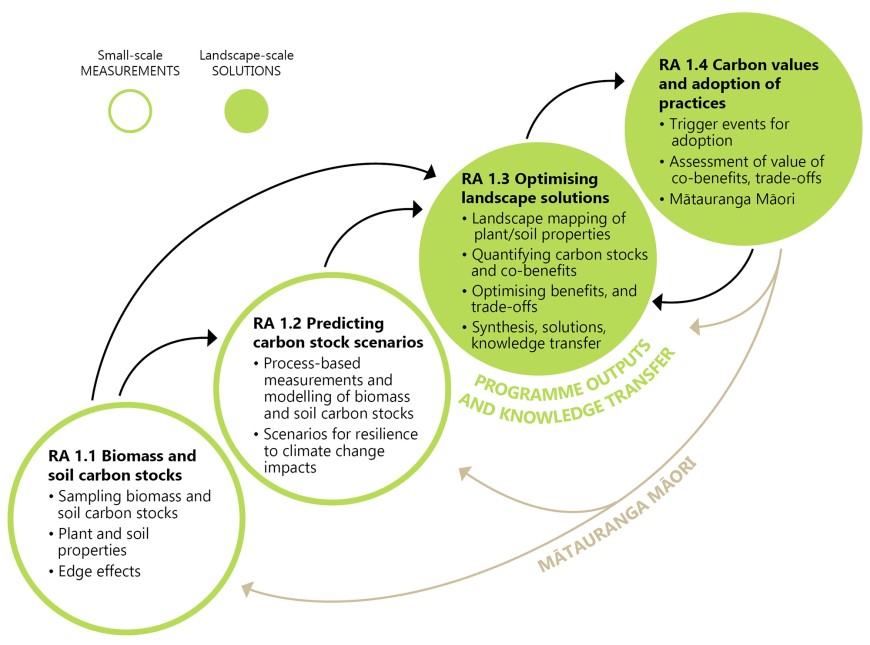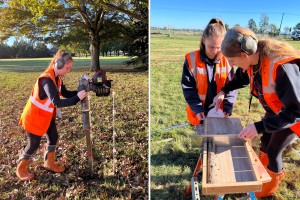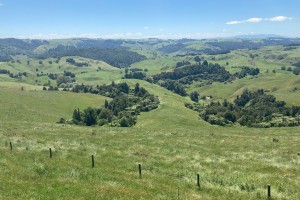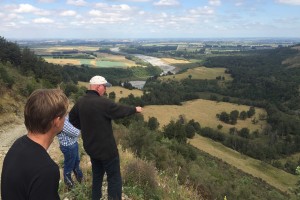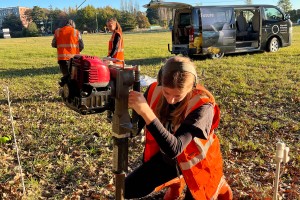Trees in landscapes | Te Kapunipunitanga a Tāne Mahuta
In this section
- Land resources and climate change
Te Kapunipunitanga a Tāne personifies groups of trees into beings, in the mind’s eye a vast landscape of trees rising up, grouping and emerging forth (Doug Macredie & Karu Kukutai)
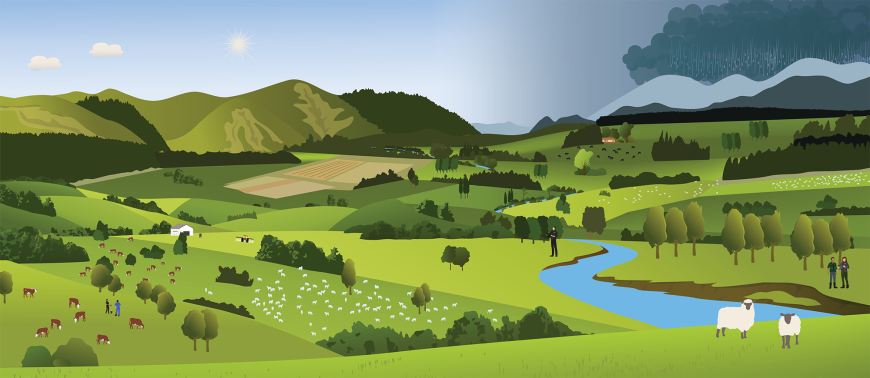
Increasing carbon stocks from establishing new plantation forests on low-productivity grasslands is seen as a major contributor to Aotearoa New Zealand meeting our net zero CO2 emissions target by 2050 and the Climate Change Commission has recommended establishing 680,000 ha of new forests, using a combination of plantation and native species by 2035. However, present policy only allows landowners to account for increases in biomass carbon storage in large blocks of trees and does not include biomass carbon in small wood lots, isolated or clusters of trees and changes in soil carbon.
Right now, we tend to think of forestry in terms of monoculture pine plantations because they are fast to grow. But there are increased risks with monoculture plantations: they can increase fire risk, reduce biodiversity and are susceptible to pest incursions.
As an alternative, can the integration of smaller, multifunctional, and diverse groupings of trees across landscapes achieve greater sequestration while providing additional co-benefits?
We already do this to some extent. Think of trees in gullies or steep slopes to reduce erosion, and riparian plantings for improving water quality. But there are still large areas of low productivity grasslands on moderately sloping land where trees could be integrated.
But why would these smaller diverse plantings be more effective than monoculture plantations? One major reason is edge effects that are the key difference between how trees grow on the edges of groups of trees compared to the interior.
Evidence from Europe demonstrates that trees on the edges of forests and stands are larger. There is also some evidence that soil carbon stocks are increased around the edges of groupings of trees. But these opportunities to increase carbon stocks have not yet been tested in Aotearoa New Zealand
We invite you to engage with us as we investigate how we can achieve greater carbon sequestration and provide additional benefits to enhance the resilience of rural communities by integrating smaller, multifunctional, and diverse groupings of trees into landscapes.
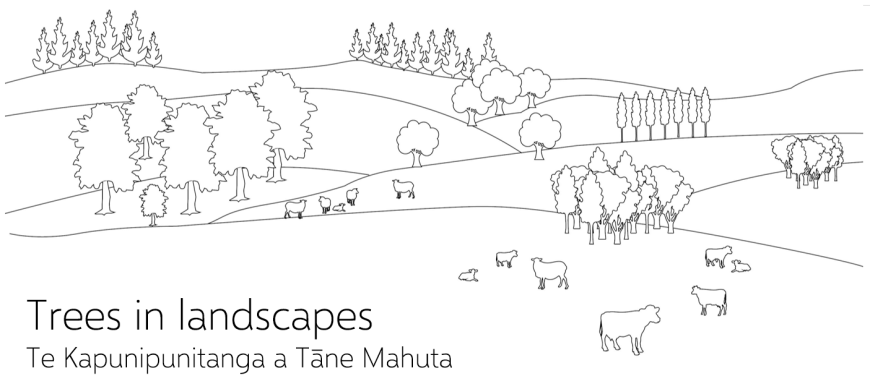
Overall aim of the programme
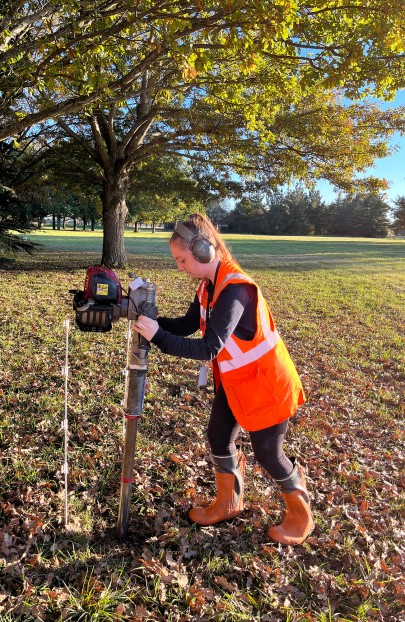
Katie O’Hagan, an honours student at the University of Canterbury, taking a soil core at the Manaaki Whenua site in Lincoln.
Increasing carbon stocks from establishing new plantation forests on low-productivity grasslands is seen as a major contributor to New Zealand meeting our net zero CO2 emissions target by 2050. However, present policy only allows landowners to account for increases in biomass carbon storage in large blocks of trees and does not include biomass carbon in small wood lots, isolated or clusters of trees and changes in soil carbon. We aim to demonstrate that tactical establishment of small clusters of trees and native tree regeneration in grasslands using species matched to soil and climatic conditions will protect and add value to the rural sector.
Increased biomass and soil carbon stocks will directly contribute to mitigation of greenhouse gas emissions, reducing resultant climate change impacts. Increasing the diversity of clusters of trees in landscapes will provide additional co-benefits including increasing diversity of products (e.g. nuts, honey), provision of alternative animal fodder, improving animal welfare by providing shelter, reduced erosion, reduced nutrient leaching improving water quality, enabling of kaitiakitanga in rural landscapes, and enhanced well-being and improved life outcomes for rural communities.
Overview
Action to help New Zealand meet its net zero carbon emissions target by 2050 has a current focus on the establishment of new forests. We propose that the targeted integration of isolated or small clusters of trees into low to mid-sloping grasslands will provide an alternative to large-scale conversion to exotic forests, with substantial economic increases in carbon credits and additional co-benefits for animal fodder and shelter, reduced erosion, increasing farm resilience to climate extremes, increased visual amenity, and the enabling of kaitiakitanga. We aim to test that this approach will lead to increases in biomass and soil carbon stocks that exceed those for the same ground area of continuous forestry, contributing significantly to low-emissions and climate-resilient agricultural practices.
For the first time we will quantify the enhanced biomass and soil carbon stocks associated with edge effects at tree/grassland boundaries in hill country widespread in rural New Zealand. Across these boundaries we will determine the soil microbial mechanisms regulating decomposition and stabilisation of soil carbon using key soil properties and next-generation DNA metagenomics. We will then develop and validate microbially explicit ecosystem models to predict changes in carbon stocks at site scale. From this we will undertake quantitative scenario modelling, incorporating decision constraints by land managers, to predict the economic, environmental and cultural value of increased carbon stocks at landscape scale and recommend the optimal spatial establishment of tree clusters for benefits and their value across nature’s contribution to people.
Our research will strengthen the country’s international reputation for action to mitigate and adapt to climate change, support landowners including Māori to deliver sustainable land management, enabling kaitiakitanga, well-being, and the prosperity of the rural sector.
Critical issues
- New Zealand has a target to reach net zero carbon emissions by 2050
- Establishment of new forests is highlighted as a major contribution to reaching the target
- 8 Mha hill country are available for changes in land use
- Large scale plantation forestry sequesters carbon and provides timber resources but there are impacts that land-use is locked in, livelihoods for rural communities are compromised and fire and slash accumulation risks are increased
- There are large uncertainties in changes in soil carbon stocks when converting grassland to forest
- Beneficial edge effects associated with tree clusters are not quantified
- Matching soil/climate to tree type to maximise benefits is not well tested
- Optimal landscape design using tree clusters is not yet tested
- Co-benefits of tree clusters are not quantified
Outcomes
Short term
- Increased awareness by land managers of opportunities to increase environmental, economic, social and cultural benefits
- Findings inform landscape design
- Findings inform emission reduction policies
- Enhanced kaitiakitanga
Mid term
- Increased profitability
- More resilient agricultural systems
- New policy development for allowing farmers to account for increasing carbon stocks
- Barriers to establishing tree clusters on farms are overcome
Long term
- NZ meets net zero carbon target
- Improved environmental outcomes
- Enhanced exports and revenue for New Zealand
- Blueprint for future landscape design
Benefits to New Zealand
We aim to demonstrate the benefits from increases in biomass and soil carbon stocks associated with edge effects from small clusters of trees. The adoption of practices to establish tree clusters in landscapes matched to soil type and climate conditions following recommendations from our research could start by 2026.
The government is proposing the establishment of 680,000 ha (modified from the earlier estimate of 710,000 ha) of forests by 2035 to contribute to meeting the net zero carbon emissions target by 2050. As an alternative to avoid the unintended consequences of large-scale plantation forestry, including impacts on livelihoods in rural communities and increased fire risk, we aim to demonstrate the benefits from increases in biomass and soil carbon stocks associated with edge effects from small clusters of trees.
Compared with plantation forestry, over 30 years, we estimate that establishing mosaics of tree clusters on low-productivity grasslands on 25% of the land area recommended for forestry could result in additional biomass and soil carbon stocks equivalent to offsetting 1.5 years of New Zealand’s current gross greenhouse gas emissions or 3 years of New Zealand’s agricultural emissions. The additional carbon stock would be equivalent to 8% of the proposed total emissions allowable to meet the net zero carbon emissions target by 2050 and contribute additional carbon credits of up to $1.9 billion compared with permanent forestry. We estimate that the additional co-benefits to nature’s contribution to people, including climate resilience, could be $0.67 billion over 30 years. Our research will support Māori to deliver economic and environmental outcomes and enhance kaitiakitanga. Our findings will improve New Zealand’s reporting of greenhouse gas emissions and enhance our international reputation for action to mitigate and adapt to climate change.
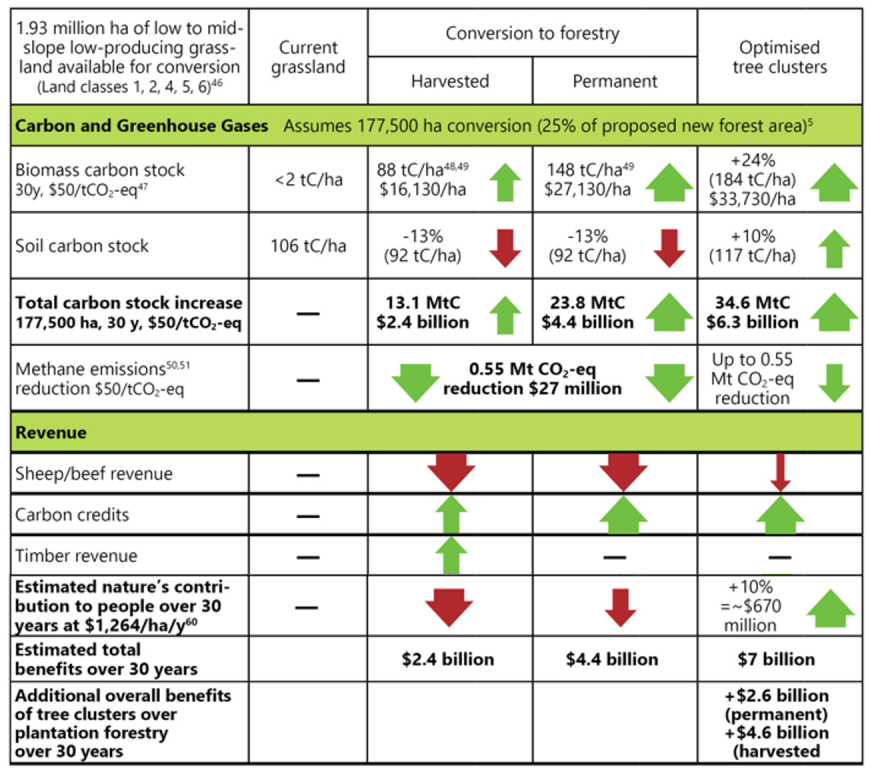
Table: Benefits to New Zealand
Vision Mātauranga
This research builds on established relationships and on ongoing collaborative work with an ahuwhenua Māori Trust at Te Whaiti, existing Māori special interest groups (e.g. the Kānuka Entity, Ngā Pou a Tāne / National Māori Forestry Association) and Māori agents of change in the agribusiness sector. The programme supports the aspirations of our partners to discover prosperous land use opportunities that are consistent with their values as Māori.
Research Plan
We will develop new approaches to measuring and modelling the mechanistic processes regulating edge effects on biomass production and soil carbon cycling for clusters of trees with different traits in grasslands in relation to pedoclimatic conditions. We will scale our findings to inform optimal landscape design, quantify the economic, environmental and cultural co-benefits and translate research findings into recommendations for action.
We will undertake the first trans-disciplinary attempt to develop new approaches to measuring and modelling the mechanistic processes regulating edge effects on biomass production and soil carbon cycling for clusters of trees with different traits in grasslands in relation to pedoclimatic conditions. We will scale our findings to inform optimal landscape design, quantify the economic, environmental and cultural co-benefits and translate research findings into recommendations for action.
Our work programme is organised into four linked Research Aims:
- pdf How can small clusters of trees add value to rural landscapes Q&A pdf File, 204 KB
- pdf How can small clusters of trees add value to rural landscapes Presentation pdf File, 6.9 MB
Collaborators

Led by Manaaki Whenua – Landcare Research with collaborators.
Working with support and advice from our End User Advisory Group from:
Ministry for Primary Industries (MPI), Ministry for the Environment (MfE), Waikato Regional Council, Hawkes Bay Regional Council, Beef+LambNZ, PĀMU, Hikurangi Bioactives, Kānuka Entity, Ngā Pou a Tāne, Tāne’s Tree Trust.
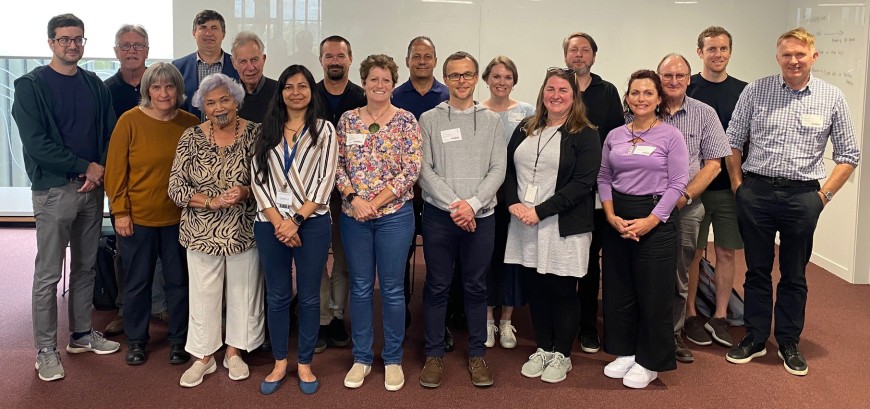
Trees in Landscapes hui, February 2023.
Key contacts

David Whitehead


